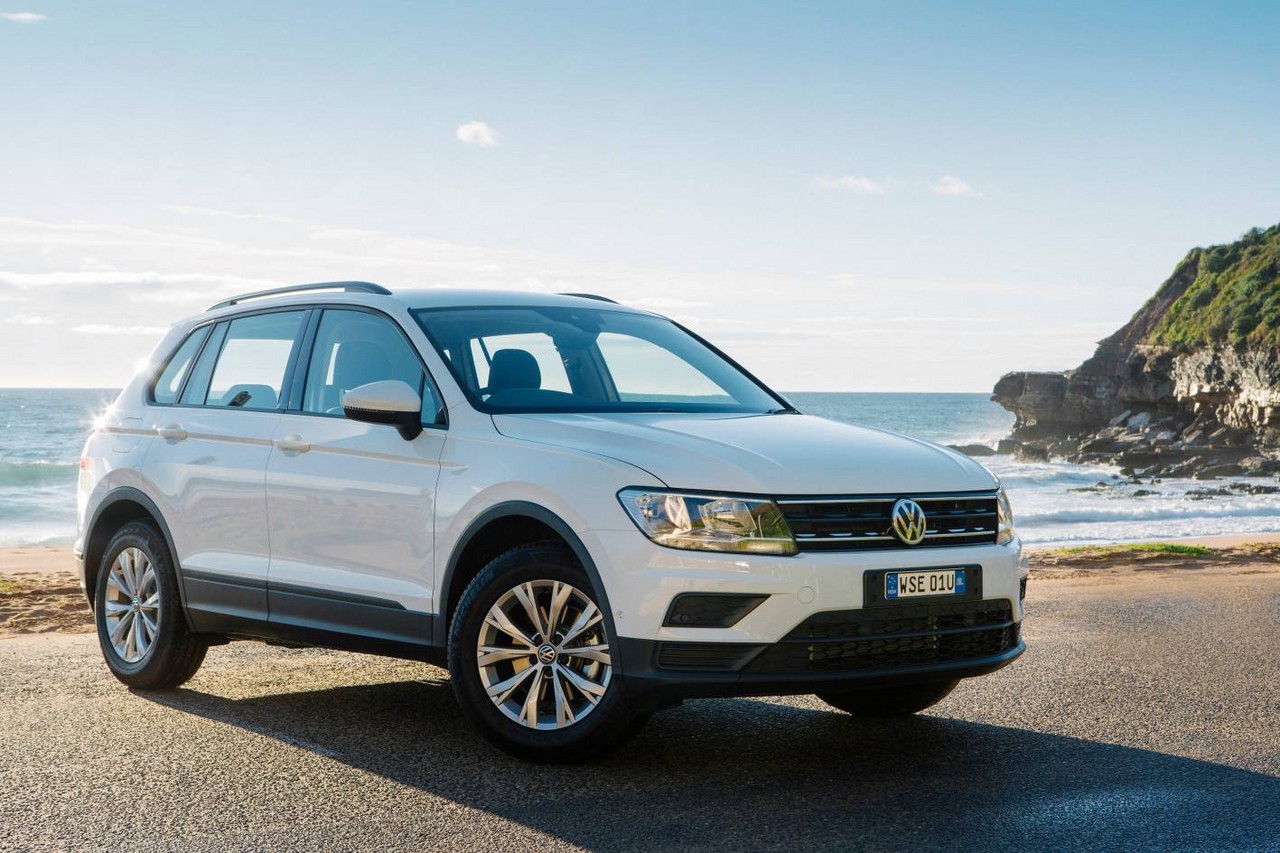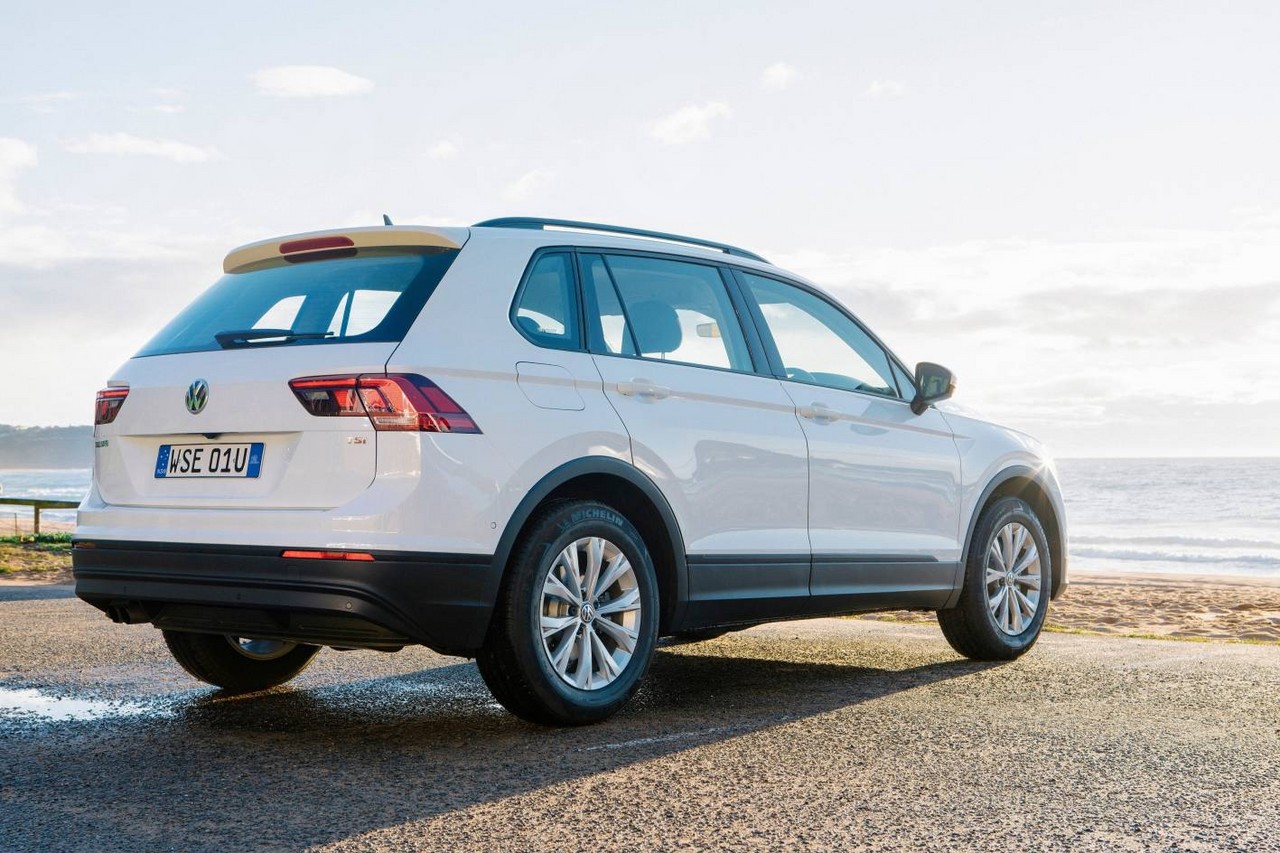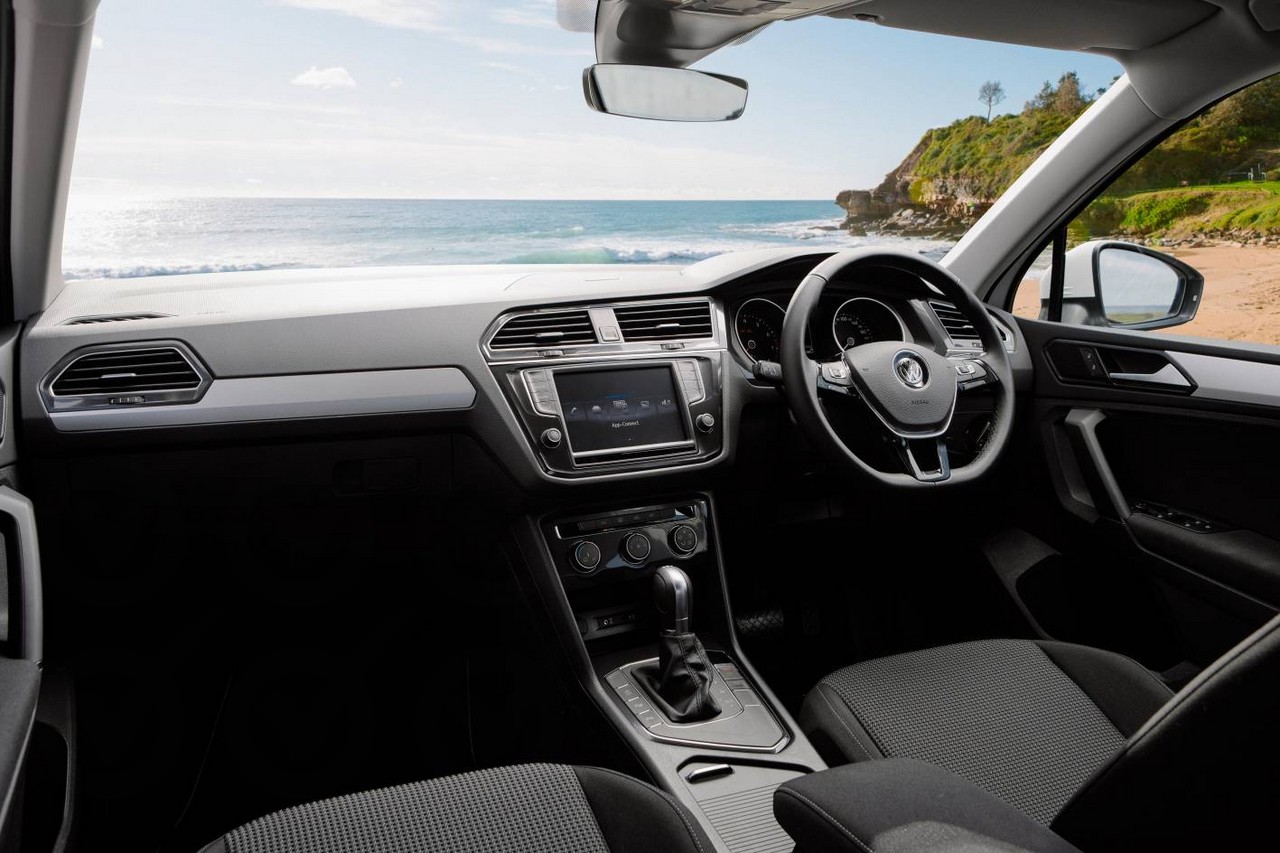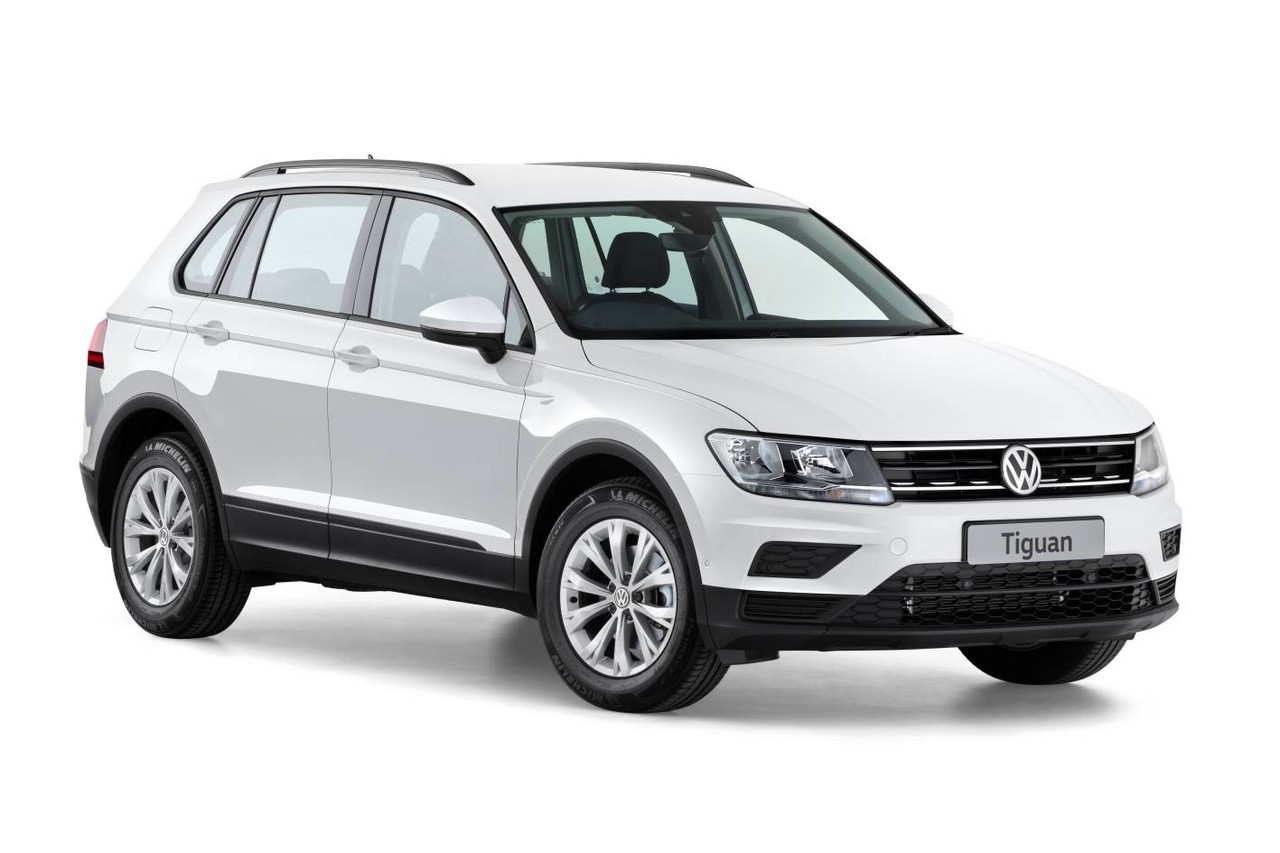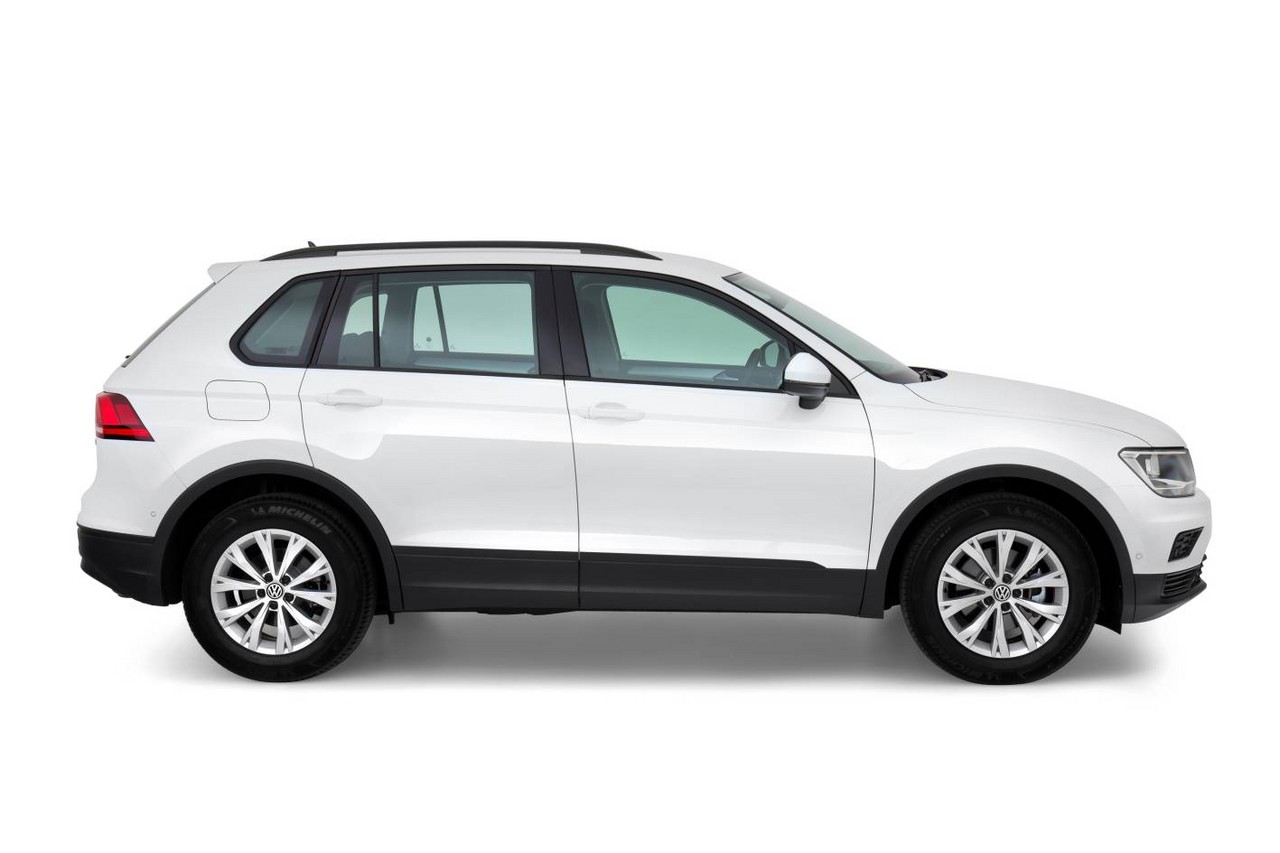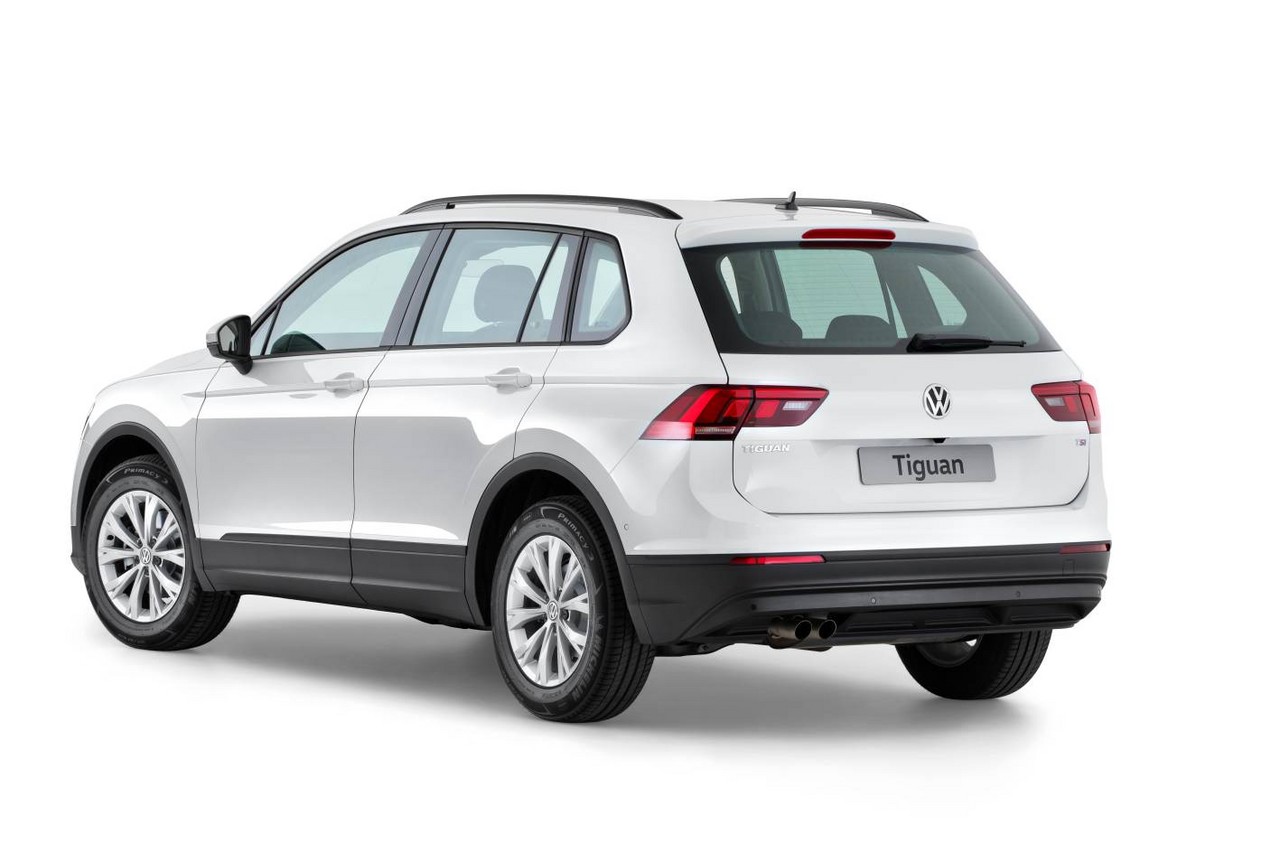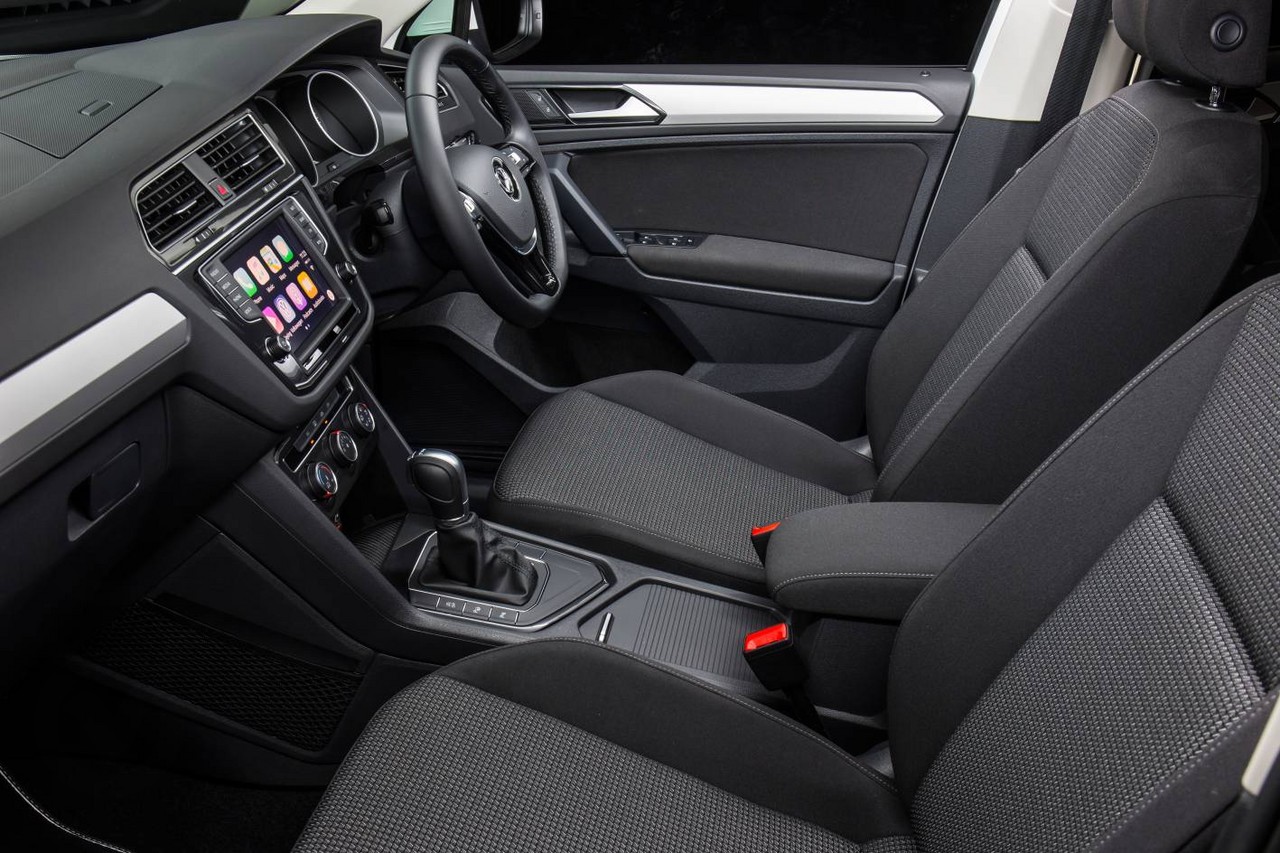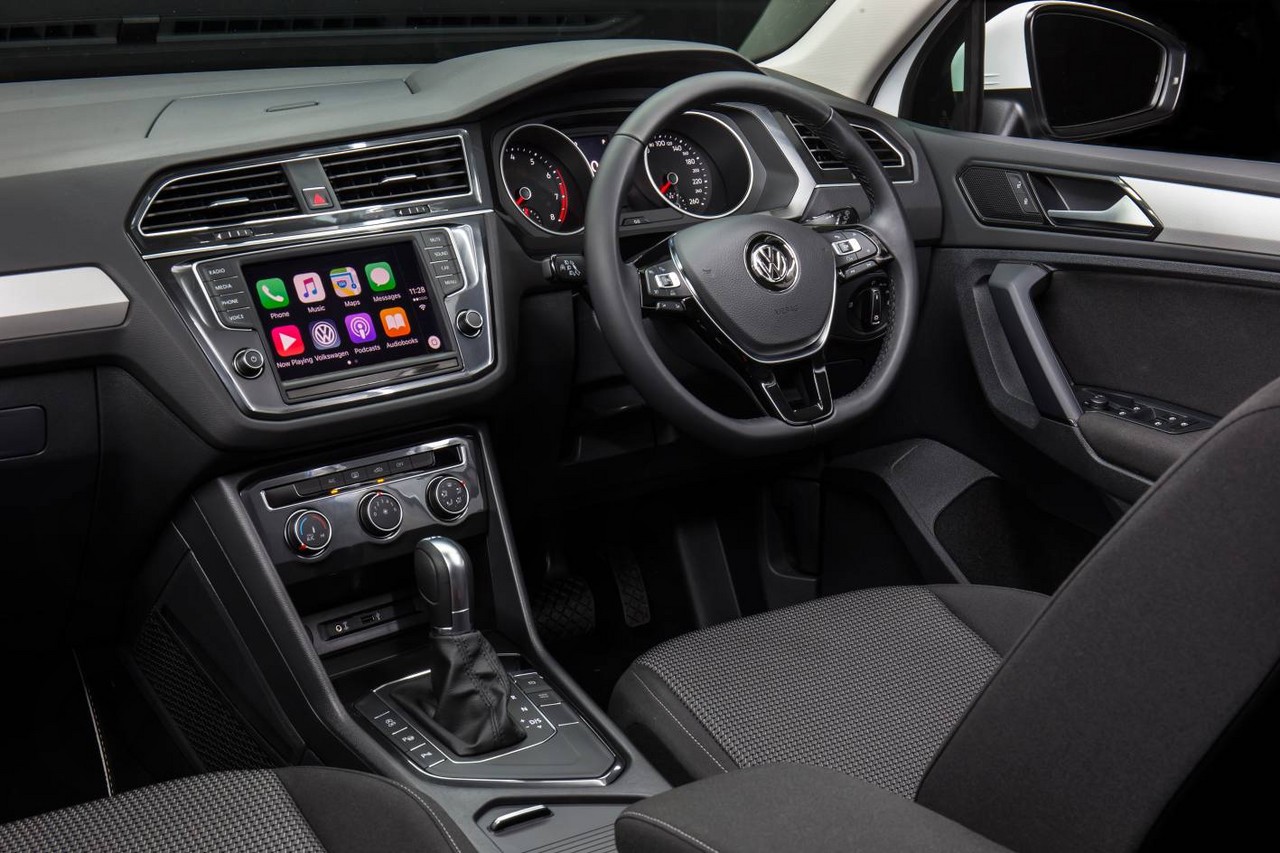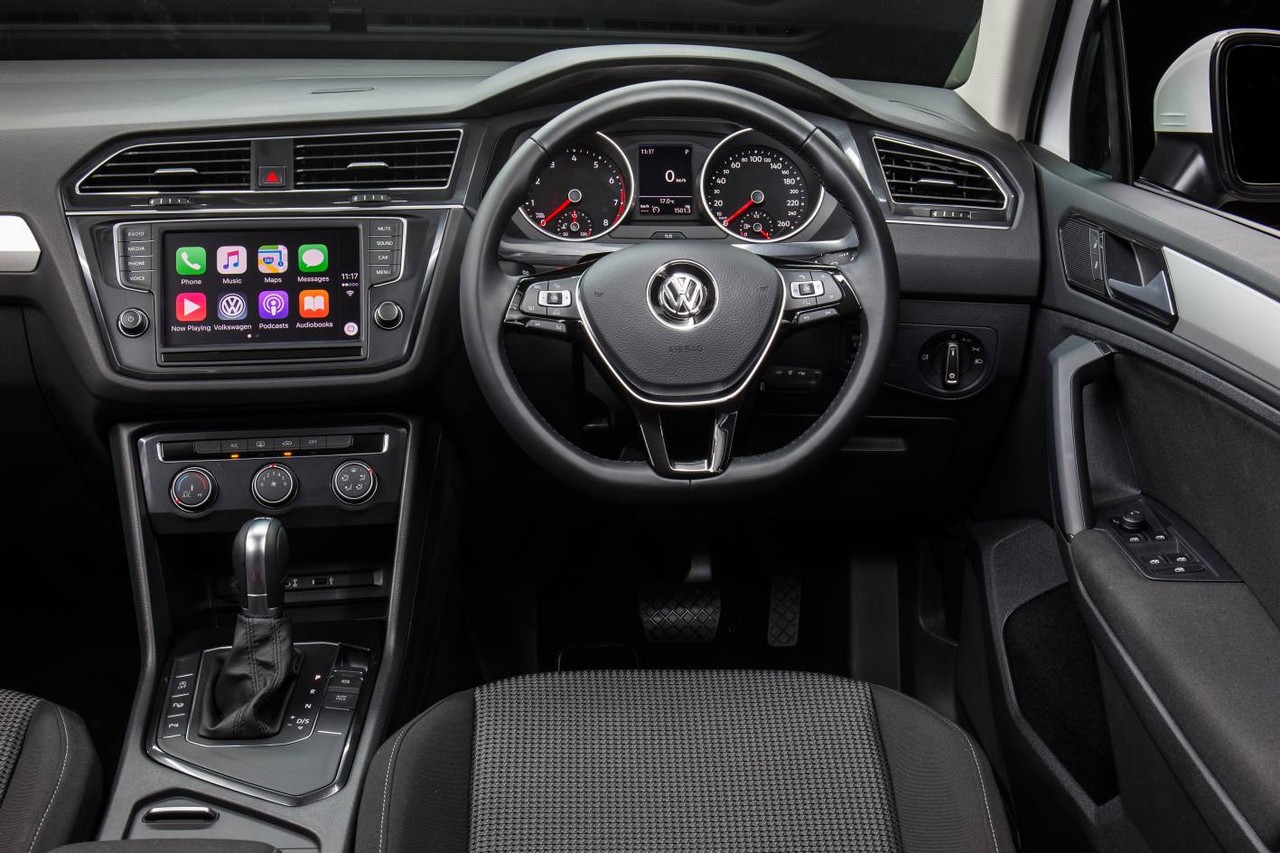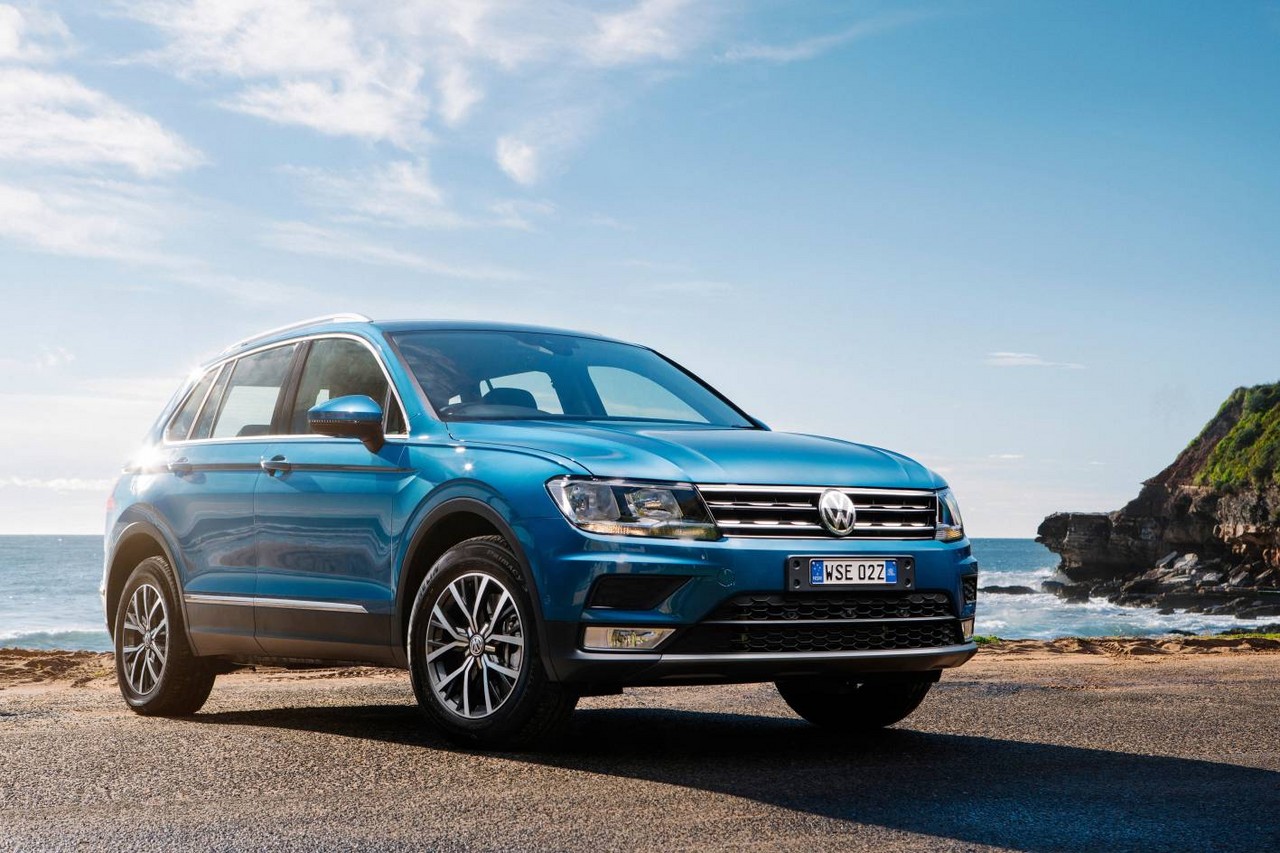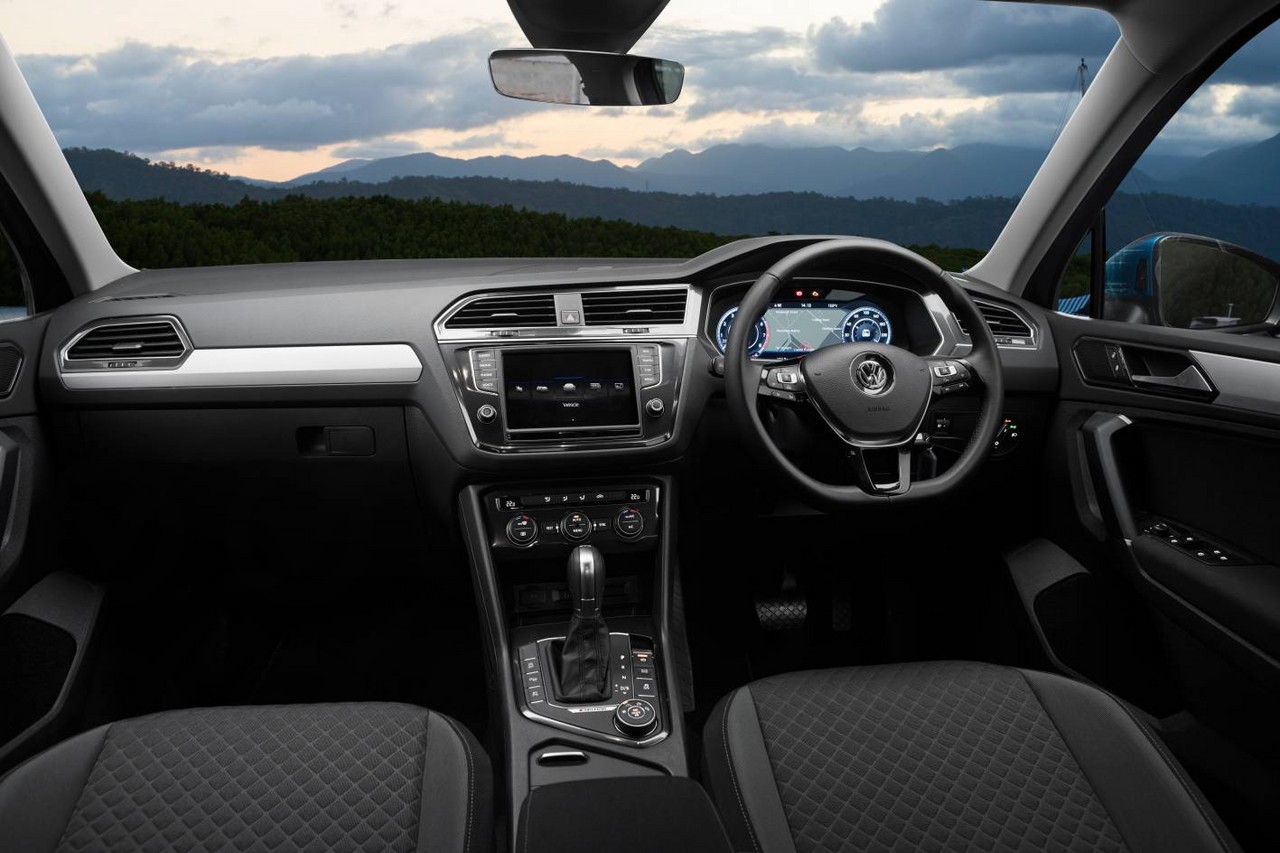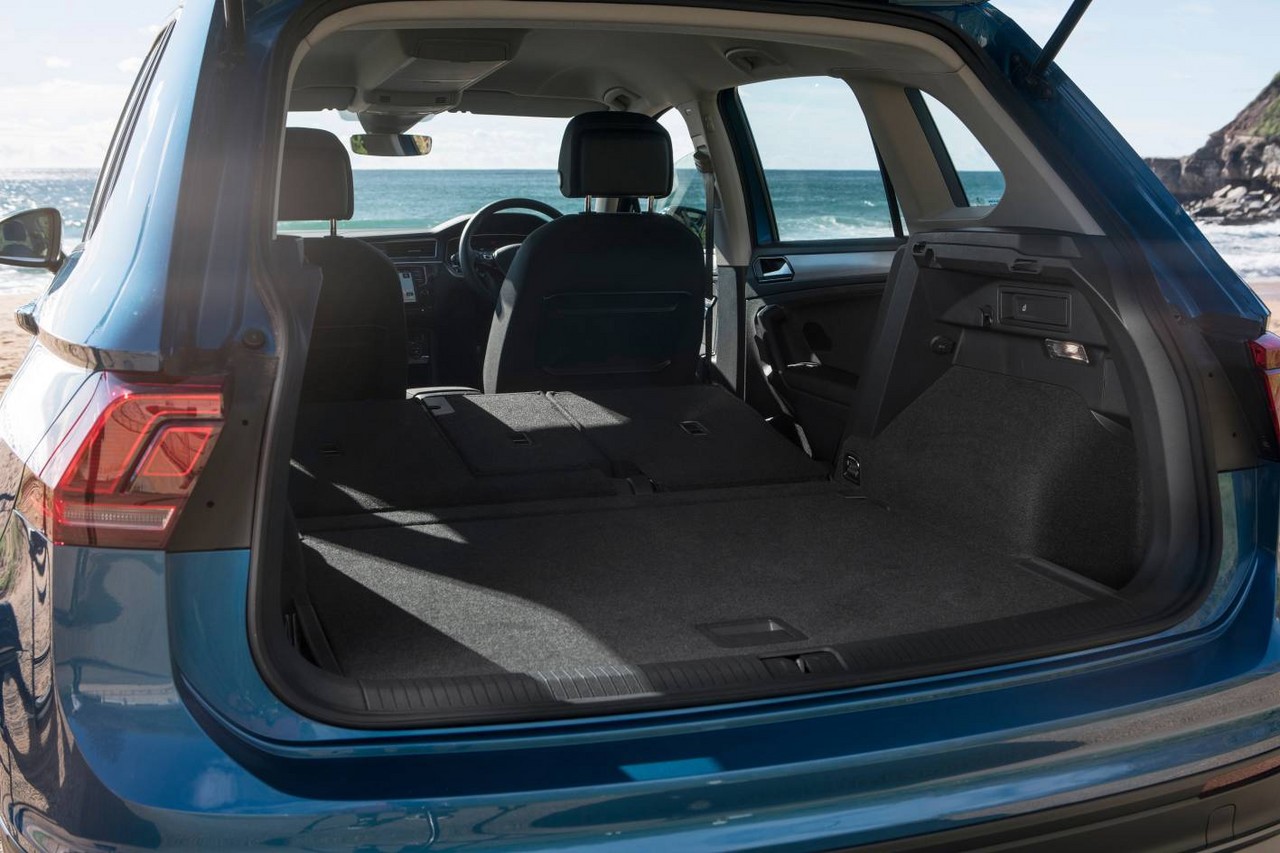
- Spacious and practical interior with sliding rear seats
- Impressive ride/handling balance
- Refined diesel engines
- Active safety technologies fitted as standard
- Suspension slightly lacking in low-speed compliance
- Dull driving experience
- Some wind noise around door mirrors
Overview
Released in Australia in September 2016, the second-generation Volkswagen AD1 Tiguan was a mid-size SUV. Manufactured in Wolfsburg, Germany, the Volkswagen AD1 Tiguan range consisted of petrol-engined 110 TSI CoD (Cylinder-on-Demand), 132 TSI 4MOTION and 162 TSI 4MOTION variants, and diesel-engined 110 TDI 4MOTION and 140 TDI 4MOTION variants. The Volkswagen AD1 Tiguan range initially consisted of Trendline, Comfortline and Highline editions, with the Sportline following in December 2017.
To reduce fuel consumption, all powertrains had:
- An ‘automatic start-stop’ function which could shut down the engine when the vehicle was stationary in traffic; and,
- A ‘brake energy recuperation’ system which used an ‘intelligent’ alternator that increased its output during braking and coasting phases and temporarily stored this energy in the battery so that it could be used to power the vehicle’s on-board electrical system when the driver next accelerated.
From August 2017, the Volkswagen AD1 Tiguan was available in Adventure editions.
| Variant | Edition | Engine | Trans. | Peak power | Peak torque |
|---|---|---|---|---|---|
| 110 TFSI CoD | Trendline | 1.4-litre CZEA turbo petrol I4 | 6sp man., 7sp DCT |
110 kW at 6000 rpm | 250 Nm at 1500-3500 rpm |
| Comfortline, Adventure |
1.4-litre CZEA turbo petrol I4 | 7sp DCT | |||
| 132 TSI 4MOTION | Comfortline, Adventure |
2.0-litre CZPA turbo petrol I4 | 7sp DCT | 132 kW at 3940-6000 rpm | 320 Nm at 1500-3940 rpm |
| 162 TSI 4MOTION | Highline | 2.0-litre CHHB turbo petrol I4 | 6sp DCT | 162 kW at 4500-6200 rpm | 350 Nm at 4400 rpm |
| Variant | Edition | Engine | Trans. | Peak power | Peak torque |
|---|---|---|---|---|---|
| 110 TDI 4MOTION | Comfortline | 2.0-litre CRBC/CRLB turbo diesel I4 | 7sp DCT | 110 kW at 3500-4000 rpm | 340 Nm at 1750-3000 rpm |
| 140 TDI 4MOTION | Comfortline, Highline |
2.0-litre turbo diesel I4 | 7sp DCT | 140 kW at 3500-4000 rpm | 400 Nm at 1900-3300 rpm |
4-Motion all-wheel drive system with Active Control
The Volkswagen Tiguan 4Motion had a Haldex 5 all-wheel drive system which consisted an electronically controlled and hydraulically actuated multi-plate clutch coupling (located in front of the rear axle differential at the end of the prop shaft). Under low loads or when coasting, the rear axle was decoupled to reduce fuel consumption. If, however, there was a loss of front wheel traction or such a loss is anticipated by on-board sensors, then an electro-hydraulic oil pump applied pressure to the clutch plates to transfer up to 50 per cent of the engine’s torque to the rear wheels (for a 50:50 front:rear torque split).
For the Volkswagen AD1 Tiguan, the driver could use an ‘Active Control’ dial to select from Normal, Snow, Off-road and Off-road Individual settings.
Dimensions and body
The Volkswagen AD1 Tiguan was underpinned by Volkswagen’s Modular Transverse Matrix (MQB) platform which was shared with vehicles such as the Volkswagen Mk.7 Golf and Volkswagen Mk.7 Passat . According to Volkswagen, the AD1 Tiguan had a torsional rigidity of 28,000 Nm/degree (25,000 Nm/degree for models with the optional panoramic roof).
Compared to the Volkswagen 5N Tiguan , the AD1 Tiguan was 60 mm longer (at 4486 mm), 30 mm wider (1839 mm), 17 mm lower (1648 mm) and had a 77 mm longer wheelbase (2681 mm). Furthermore, the AD1 Tiguan had a drag co-efficient of 0.32 Cd (0.37 Cd for the 5N Tiguan) and was around 50 kg lighter for comparable variants.
The Volkswagen AD1 Tiguan had a sliding rear bench seat that provided up to 180 mm of longitudinal adjustment. The Tiguan had a cargo capacity of 615 litres with the rear seats slid forward, though this increased to 1655 litres when the rear seat backrests were folded and luggage was stored to the roofline.
Suspension
The Volkswagen AD1 Tiguan had MacPherson strut front suspension with lower A-arms and independent, four-link rear suspension. As an extra-cost option (and included in the ‘R-Line package’), the Tiguan could be specified with Volkswagen’s ‘Dynamic Chassis Control’ (DCC) which consisted of electronically controlled dampers that could vary damping resistance according to road conditions and driver behaviour; the driver could also select from Sport, Comfort and Normal settings.
Steering
The Volkswagen AD1 Tiguan had rack-and-pinion steering with speed-sensitive, electric power assistance; its turning circle was 11.5 metres.
Safety equipment
Standard safety equipment for the Volkswagen Tiguan included dual front airbags, a driver’s knee airbag, front seat-mounted side airbags, full-length curtain airbags, ABS, electronic brake force distribution, electronic stability control, traction control and front seatbelts with pre-tensioners and load limiters.
For Australia, the Volkswagen Tiguan was fitted with the following safety technologies as standard:
- Front Assist: used a radar sensor to detect if the vehicle was closing too fast on the vehicle ahead. If this occurred, Front Assist 1) provided audible and visual warnings to the driver, 2) brought the brake pads into contact with the brake discs in preparation for an emergency stop; and, 3) provided a jolting brake application to alert the driver. If the driver failed to respond, Front Assist would apply the brakes automatically to avoid or reduce the severity a collision;
- City Emergency Brake: an extension of Front Assist, City Emergency Braking operated at speeds up to 65 km/h and used a radar sensor and front camera to monitor the area ahead for vehicles and pedestrians. If a collision was anticipated, the driver would be alerted via visual and audible warnings, followed by jolting brake application. If the driver failed to respond, the system would initiate emergency braking;
- Lane Assist (lane departure warning): using a camera to recognise lane markings, Lane Assist could detect unintentional lane drifting or changing and provide corrective steering actions for up to eight seconds. If the corrective steering actions were insufficient, the driver would be warned via steering wheel vibrations;
- Automatic Post-Collision Braking System: activated when two independent sensors detected that a collision had occurred and the driver did not respond. Automatic post-collision braking applied the brakes to achieve controlled deceleration to a speed of 10 km/h to minimise the risk of the vehicle being involved in secondary collisions;
- Fatigue Detection: monitored driver behavior at speeds in excess of 65 km/h for signs of fatigue. If the driver exhibited signs of fatigue, a tone would sound and a warning would appear in the multi-function display; and,
- An Active Bonnet: in the event of a frontal collision with a pedestrian or cyclist, the bonnet would rise by 50 mm within 22 milliseconds to provide clearance over ‘hard points’ in the engine bay and reduce impact severity.
Driver Assistance package
As an extra-cost option, the Volkswagen Tiguan Comfortline and Highline could be specified with a ‘Driver Assistance package’ which included:
- Adaptive Cruise Control (ACC): using a radar sensor, ACC could maintain a pre-set distance to the vehicle ahead (including autonomous braking) and cause the vehicle to accelerate to its pre-set speed after braking;
- Side Assist (lane change assistant): operated at speeds above 60 km/h and used two radar sensors in the rear bumper to monitor the area up to 70 metres behind the vehicle. If a vehicle was detected approaching from the rear or alongside the Tiguan, the driver would be warned by illumination of an LED in the door mirror housing. If the driver then activated the turn indicator in the direction of the detected vehicle, the Side Assist indicator would flash to draw the driver’s attention to the mirror. If the driver attempted to steer into that area, the Lane Assist system provided a counter-steering action to prevent the lane change;
- An ‘Active Info Display’ which replaced the instrument cluster with a fully configurable 312 mm TFT display; and,
- A 360-degree ‘Area View’ function which utilised four cameras – in the bootlid, both door mirrors and radiator grille – to provide obstacle detection and a 3D bird’s eye view of the vehicle. From the Display menu, the driver could select the camera views (front, rear, side or bird’s eye view) with either a full or split screen.
The Driver Assistance package also included power folding door mirrors.
Euro NCAP testing
In Euro NCAP testing , the Volkswagen AD1 Tiguan received a five star safety rating which included a 96 per cent adult occupant protection rating and an 84 per cent child occupant protection rating. In the frontal offset test, protection of the front occupants was generally rated as good, though chest protection was rated as adequate (i.e. a slight risk of serious injury). Furthermore, maximum points were awarded in the side impact and pole tests.
Features: Volkswagen Tiguan Trendline
Standard features for the Volkswagen Tiguan Trendline included 17-inch alloy wheels, Volkswagen’s ‘Composition Media’ radio system with eight speakers, a CD player, auxiliary-in socket (3.5 mm), USB interface and an eight-inch display, Bluetooth mobile phone connectivity and audio streaming, air conditioning, cruise control, a rear view camera, halogen headlights, rain-sensing wipers, leather multi-function steering wheel, split-folding rear seats, remote central locking, power adjustable and heated door mirrors, power windows, a height and reach adjustable steering wheel, an auto-dimming rear view mirror, 12 volt power sockets (centre console, rear and luggage compartment), low tyre pressure indicator, black roof rails, LED tail-lights, a trip computer, an alarm and immobiliser.
As standard, the Tiguan Trendline was also fitted with Volkswagen’s third generation ‘Park Assist’ system which provided parking space detection, automated steering for parallel and perpendicular parking, and exiting from parallel parking spaces.
Features: Volkswagen Tiguan Comfortline
Compared to the Tiguan Trendline, the Tiguan Comfortline was further equipped with satellite navigation, three-zone climate control air conditioning, front fog lights, folding front seatback tables, extended roof storage console, storage drawers under the front seats, a luggage floor net, floor mats and a colour multi-function display.
Visual cues for the Tiguan Comfortline included chrome roof rails, chrome window surrounds and painted bumper inserts.
Features: Volkswagen Tiguan Highline
Relative to the Tiguan Comfortline, the Tiguan Highline was distinguished by its 18-inch alloy wheels, ‘Discover Pro’ satellite navigation system with an eight-inch display, ‘Vienna’ leather upholstery, front sport seats with heating, a power adjustable front sport seat, LED headlights with dynamic cornering lights, steering wheel gearshift paddles, proximity key (i.e. keyless entry), power folding door mirrors, ambient lighting, LED reading lights, power-operated tailgate with Easy Open and Close, and rear privacy glass.
The Tiguan Highline could be identified by the chrome strip in its front lower air intake.
Tiguan Highline: R-Line package
As an extra-cost option, the Tiguan Highline could be specified with an ‘R-Line’ package which includes 20-inch alloy wheels, an R-Line body kit and R-Line interior. The R-Line package also included Volkswagen’s ‘Dynamic Chassis Control’ (DCC, described under ‘Suspension’) and progressive ratio steering.
2017 Volkswagen Tiguan Adventure
Available in 132TSI and 110DI variants, the Volkswagen Tiguan Adventure was released in August 2017. Based on the Tiguan Comfortline, the Tiguan Adventure could be identified by its ‘off-road’ front bumper which enabled a 24 degree approach angle, underbody protection, and ‘off-road’ labelled aluminium front door sill inlays.
Compared to the Tiguan Comfortline, the Tiguan Adventure was further equipped with 18-inch ‘Nizza’ alloy wheels, an ‘ErgoActive’ driver’s seat with fourteen-way adjustment (including power lumbar adjustment) and massage function, heated front seats, ‘Art Velours’ micro-fleece upholstery, LED headlights, proximity key (i.e. keyless entry), power folding door mirrors, push-button start and a power-operated tailgate. As standard, the Tiguan Adventure was fitted with Volkswagen Genuine Accessory roof bars.
2017 Volkswagen Tiguan 162TSI Sportline
The Volkswagen Tiguan 162TSI Sportline was released in Australia in December 2017. Compared to the Tiguan Comfortline, the Tiguan 162TSI Sportline was equipped with the “Driver Assistance package’, 20-inch Kapstadt alloy wheels, dynamic chassis control (DCC) and, inside, featured ‘sport comfort’ seats finished in microfleece and cloth upholstery. The Volkswagen Tiguan 162TSI Sportline had a recommended retail price of $45,990 (excluding on-road costs).
2018 Volkswagen Tiguan 162TSI Wolfsburg Edition
Based on the Tiguan 162TSI Highline, the Tiguan 162TSI Wolfsburg Edition was released in Australia in October 2018. As standard, the Tiguan 162TSI Wolfsburg Edition was equipped with a head-up display, ‘Sound & Vision’ package and ‘R-Line’ packages. Furthermore, the Tiguan 162TSI Wolfsburg Edition could be identified by its 20-inch black ‘Suzuka’ alloy wheels, black exterior trim and rear privacy glass.
2019 Volkswagen Tiguan 132TSI R-Line Edition
The Volkswagen Tiguan 132TSI R-Line Edition was released in Australia in April 2019. Based on the 132TSI Comfortline, but fitted with an R-Line package which included two-tone ‘Race’ cloth upholstery, 19-inch Sebring alloy wheels, Volkswagen’s ‘Active Info’ display and tinted windows. As standard, the Tiguan 132TSI R-Line Edition was also fitted with the Driver Assistance Package (i.e. Adaptive Cruise Control, Traffic Jam Assist, Side Assist, Rear Traffic Alert and Emergency Assist). Australian deliveries of the Tiguan 132TSI R-Line Edition were limited to 1000 vehicles.
Related links
- Specifications: Volkswagen AD1 Tiguan (September 2016)
- Behind the Wheel: 2018 Volkswagen Tiguan Review
- Volkswagen Media: World Premiere of the new Tiguan in Frankfurt (September 2015)
